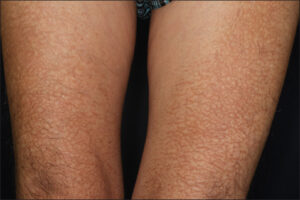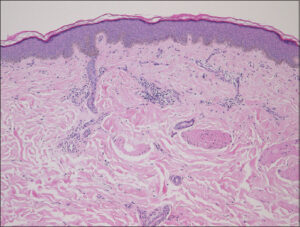Peculiar cutaneous manifestation in a Japanese patient with COVID-19 infection
Misaki Kusano , Mayu Sato, Toshiyuki Yamamoto
, Mayu Sato, Toshiyuki Yamamoto
Department of Dermatology, Fukushima Medical University, Fukushima 960-1295, Japan
Citation tools:
Copyright information
© Our Dermatology Online 2023. No commercial re-use. See rights and permissions. Published by Our Dermatology Online.
Sir,
Patients with coronavirus disease 2019 (COVID-19) are reported to present with various cutaneous manifestations, with frequencies up to over 20% [1]. Skin symptoms associated with COVID-19 are classified into maculopapular lesions, vesicular lesions, urticarial lesions, and livedoid/necrotic lesions [2,3]. We, herein, report the case of a patient presenting with an uncommon rash associated with COVID-19 infection.
A 66-year-old Japanese male with a history of diabetes mellitus, who was diagnosed with moderate COVID-19 pneumonia two months previously, was referred to our department complaining of cutaneous manifestations on both lower limbs that had appeared one month earlier. A physical examination showed brownish livedo reticularis on both lower limbs (Fig. 1). He had been taking ursodeoxycholic acid for nine days prior to the appearance of the cutaneous manifestations; thus drug eruption was suspected. A biopsy was taken to exclude drug eruption. Histological features revealed lymphocytic and histiocytic infiltration of the perivascular area within the dermis (Fig. 2). We did not observe any liquefaction degeneration. Also, vascular involvement was not observed in the dermis. A drug-induced lymphocyte transformation test for ursodeoxycholic acid was negative. We diagnosed the patient as having livedo reticularis related to COVID-19. A patch test was not performed due to a lack of consent.
 |
Figure 1: Brownish livedo reticularis on both lower limbs. |
 |
Figure 2: Lymphocytic and histiocytic infiltration of the perivascular area in the dermis (H&E, 100×). |
According to the analysis of COVID-19 cases with cutaneous manifestations in nine countries (n = 998), skin lesions were classified into five major groups. The most commonly reported skin finding was chilblain-like lesions (40.1%), followed by maculopapular lesions (23.1%), vesicular lesions (10.1%), urticarial lesions (8.7%), livedoid/necrotic lesions (2.3%), and other/non-descript rashes/skin lesions (19.8%) [4]. Galvan et al. reported that livedoid or necrotic lesions were more frequently seen in elderly or patients with severe disease, and their mortality rate was as high as 10% [5]. Livedo reticularis is an uncommon cutaneous feature associated with COVID-19 [3], and there is a small number of cases that present with livedo reticularis [6]. In a report on 738 Japanese patients with COVID-19 by Tamai et al. [7], 21 patients (2.8%) presented with COVID-19-related rash, 19 had erythematous papular lesions, and two had an urticarial rash. No patient presented with reticular eruption. There are racial differences in the frequency and type of skin symptoms in COVID-19 patients, and the frequency of occurrence and the proportion of each type of skin symptom may vary depending on race and country. However, reticular eruption is a rare type of skin symptom, and the number of global cases is small, thus further accumulation of cases is desired in the future.
Consent
The examination of the patient was conducted according to the Declaration of Helsinki principles.
REFERENCES
1. Kittler H, Tschandl P, Weninger W. Cutaneous signs in SARS-CoV-2 infection:A plea for more rigorous peer review in the time of COVID-19. Br J Dermatol. 2020;183:1140-2.
2. Marzano AV, Cassano N, Genovese G, et al. Cutaneous manifestations in patients with COVID-19:A preliminary review of an emerging issue. Br J Dermatol. 2020;183:431-42.
3. Daneshgaran G, Dubin DP, Gould DJ. Cutaneous manifestations of COVID-19:An evidence-based review. Am J Clin Dermatol. 2020;21:627-39.
4. Jia JL, Kamceva M, Rao SA, et al. Cutaneous manifestations of COVID-19:A preliminary review. J Am Acad Dermatol. 2020;83:687-90.
5. Galván Casas C, A Català, G Carretero Hernández, et al. Classification of the cutaneous manifestations of COVID-19:A rapid prospective nationwide consensus study in Spain with 375 cases. Br J Dermatol. 2020;183:71-7.
6. Sahara T, Yokota K. Livedo reticularis associated with COVID-19. Intern Med. 2022;441:61.
7. Tamai M, Sakamoto R, Goto N, Morimura O, Nishida T, Iwahashi H, et al. Cutaneous manifestations of coronavirus disease 2019 patients in Japan. J Dermatol. 2022;49:872-8.
Notes
Request permissions
If you wish to reuse any or all of this article please use the e-mail (brzezoo77@yahoo.com) to contact with publisher.
| Related Articles | Search Authors in |
|
 http://orcid.org/0000-0003-0608-114X http://orcid.org/0000-0003-0608-114X http://orcid.org/0000-0003-1439-1543 http://orcid.org/0000-0003-1439-1543 http://orcid.org/0000-0002-8390-2573 http://orcid.org/0000-0002-8390-2573 |




Comments are closed.